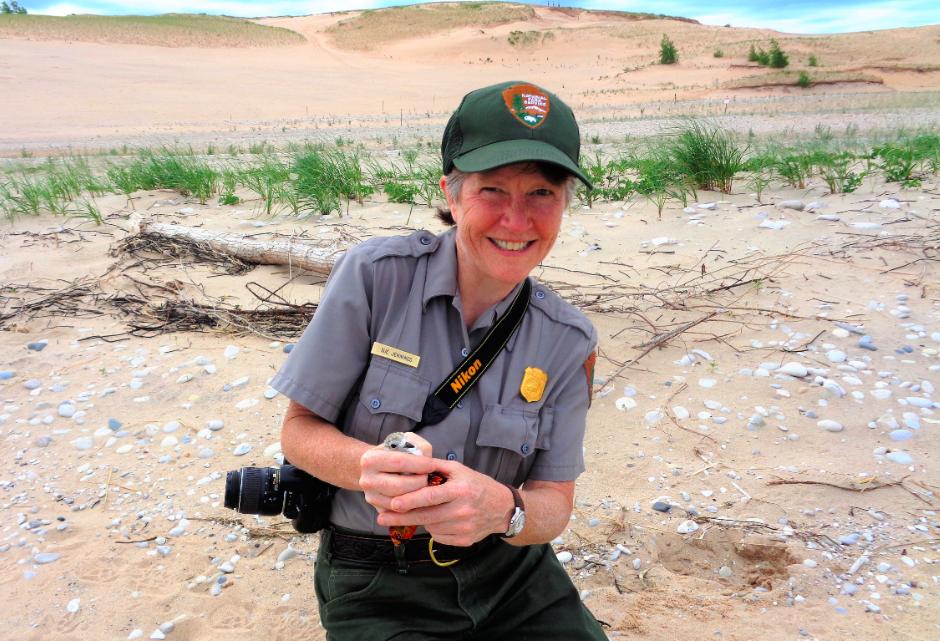
Sue Jennings / NPS
Sue Jennings, wildlife biologist at Sleeping Bear Dunes National Lakeshore, retires on December 29, 2018 after 30 years with the National Park Service - nearly 10 of them at the National Lakeshore.
Jennings, a graduate of the University of Michigan School of Natural Resources - Forestry, worked one summer for the U.S. Forest Service in Asheville, North Carolina and then a year in the bookstore at the Blue Ridge Parkway, before landing a seasonal biological technician position with the National Park Service at the Parkway in 1989. After a second season at Blue Ridge Parkway as a museum curator, Sue moved to Saint Croix National Scenic River in western Wisconsin as a natural resource specialist. Sue pioneered an innovative program to protect native river mussels, and was awarded Midwest Region Resource Manager of the Year as a result. It was at Saint Croix that Sue formed her defining philosophy of natural resource management - restoration, education, monitoring, and prevention. Sue began a career-long connection with the National Wild and Scenic Rivers Steering Committee at Saint Croix as well.
In 1996, Sue moved to the border of eastern Kentucky and Tennessee as Chief of Natural Resources at Big South Fork National River and Recreation Area. After two years, she transferred to the Midwest Region of the National Park Service in Omaha, Nebraska, first as an outdoor recreation planner and then as an environmental protection specialist. In Omaha, Sue continued her involvement with rivers, becoming the Wild and Scenic River coordinator for the entire National Park Service, as well as working on environmental planning documents across over 50 parks in the region. After a brief stint as environmental protectional specialist at Mount Rainier National Park, the National Park Service lost Sue for a little over a year as family responsibilities led her back to Omaha, this time as an environmental protection specialist working for the Federal Highway Administration. This position only deepened Sue’s connection to rivers, as she had a leadership role in planning efforts in the Missouri River basin. With the Federal Highway Administration, Sue found herself working on some of the same issues that she had worked on with the National Park Service. As Sue says, “same table, different chair.” In 2007, Sue received the River Management Society’s Frank Church Wild and Scenic Rivers Award in recognition of her many years and tireless efforts in protecting the Missouri, Little Miami, and St. Croix Rivers through the National Wild and Scenic Rivers System.
Sleeping Bear Dunes was fortunate to pluck Sue back into the National Park Service in 2009 when she moved back to Michigan as a wildlife biologist. Under Sue’s leadership at the National Lakeshore, the endangered Piping Plover shorebird has continued a strong recovery, with record numbers for nests, eggs, and chicks in 2017. Sue began the innovative “Bark Ranger” program to enlist dog owners in helping to educate their peers regarding how they can keep their furry friends from impacting plovers.
Sue’s accomplishments in natural resource protection and management have been many, and significant. Perhaps just as important, however, have been her contributions to Critical Incident Stress Management in the National Park Service. After attending a presentation on suicide within the law enforcement profession earlier in her career, Sue sought out training on Critical Incident Stress Management Peer Support Training. For over 15 years, Sue has been called upon many times to help National Park Service employees’ and visitors’ families deal with traumatic incidents of all kinds, from natural disasters to individual fatalities.
As she looks back on her career, preparing for retirement, Sue acknowledged some of her many accomplishments but said what she felt most was gratitude; for being so fortunate to have worked in public service with so many smart, dedicated, and passionate people. Anyone who has worked with Sue knows that she herself is one of the best examples.
When asked about plans for retirement, Sue cited immediate plans for sailing the Florida coast with friends, and another paddling trip to Alaska in the future. While she does plan to spend more time at home playing fiddle and reading books, Sue intends to eventually seek out more volunteer opportunities and said, “I think I have a few more backpacking trips left in me.” Sue plans to remain here in northwest lower Michigan as a home base for travel and visits from friends.



Add comment